Boat ownership is a gratifying experience. There’s enjoyment while using your vessel, but also when working on it, improving it, and updating it with new technology and hardware. However, these positive experiences can quickly turn sour if you’re not protected from various perils on and off of the water.
In this article, we discuss two items that are relatively affordable and go a long way to protect for your boat when it is docked. We’re referring to boat “bumpers” and “fenders”.
What Are Boat Bumpers and Fenders?
Bumpers and fenders are heavy-duty cushions that sit between a dock platform and a boat. They are designed to prevent rubbing and to absorb energy when a boat bounces against the dock to which it is moored.
Many people do not know the difference between bumpers and fenders and use the terms interchangeably. However, these items have clear distinctions. Simply put, boat bumpers (also known as dock bumpers) are attached to a dock, whereas boat fenders are attached to a boat.
» RELATED: Floating or Fixed Docks: Boat Insurance Pro Tip
Boat Fenders
Fenders are buoy cushions that hang between a boat and a dock platform. They help to prevent unwanted dock contact, while also protecting your boat from collision damage with neighboring vessels.
Even if your boat already has fenders tied to its sides, it’s always helpful to have a few extra ones on hand. When experiencing rough weather conditions, like strong waves and winds, you’ll find that they come in handy.
There are various boat fender options to choose from. These include traditional cylindrical fenders, molded EVA foam fenders, round/sphere boat fenders, and foam flat fenders. Here is a detailed look at each:
Cylindrical Inflatable Fenders
Cylindrical fenders are one of the more popular types of fenders. They are typically circular and have two flat ends secured with webbing or ropes. Cylindrical fenders can be inflated and deflated as needed, which is helpful when adjustments are required due to changes in air pressure or temperature.
You will commonly find these in marinas or docking areas. Most boat owners choose cylindrical fenders because they’re affordable, durable, and effective. While they generally last for several seasons, cylindrical fenders can be easily punctured or cut.
Freeboard Fenders
Freeboard fenders are typically L-shaped and stand around 15 to 24 inches tall. They are designed to sit high above the water and wrap over the corners of the gunwale. It’s important to note that freeboard bumpers have no buoyancy and cannot float.
Because freeboard fenders sit high above the waterline, they suffer less damage in severe conditions. However, they generally only last one to two years before needing to be replaced. The high positioning also causes freeboard bumpers to move around a lot with strong winds.
Round Boat Fenders
Round boat fenders are inflatable, buoyant, and made of rubber or PVC foam. They have a round design to ensure max compression space when hit by another object. Round boat fenders are also waterproof and very durable under rough conditions. After prolonged exposure to UV rays and other harsh environmental circumstances, they should remain intact and are not prone to cracking or brittleness.
Contour Fenders
Contour fenders are more rigid and durable compared to other types of inflatable fenders. They are designed with flex points, which form a horseshoe shape to protect both the hull and gunwale.
The top section goes around a boat’s rail and the bottom section extends below the waterline for extra stability while cruising. This wraparound configuration provides the highest level of protection against impact. This also means that contour fenders are more expensive and require special mounting hardware.
Pontoon Fenders
While pontoon fenders are specifically designed for pontoon boats (as their name indicates), they can also provide collision protection for other boat types. They have large contact areas, making pontoon fenders one of the more effective and durable options on the market. However, pontoon fenders are expensive and also require special mounting hardware attached to the boat’s rails or cleats.
Boat Bumpers
Proper boat bumpers can protect your vessel against any dock edges or poles. They can also prevent chips, cracks, and breakage of the dock’s wood structure. In comparison, fenders typically provide coverage around your hull and gunwale areas. Most boaters double up with both bumpers and fenders for double the protection.
» RELATED: How to Pick the Right Dock Lines
General Dock Bumpers
Dock bumpers are shorter in length and provide a buffer between your boat and the dock. They serve as protective barriers and prevent unwanted contact that often leads to costly repairs. Dock bumpers are very effective when mounted on pilings or steel beams at the slip.
Dock Edging Strips
Dock edging strips are placed around your dock and create a soft railing to prevent damage to dock boards. If your dock board is chipped, broken, or cracked due to contact, it can eventually rot if left untreated.
Edging strips also work well for metal docks and floating piers that are made of aluminum or plastic. The only downside to using dock edging strips is that it may cause minor scratches to gel coat hulls.
Post Bumpers
Post bumpers wrap around vertical dock posts, pilings, and other structures positioned at a 90-degree angle. They are designed with high-density, soft vinyl sleeves to absorb impact shocks and prevent damage to the vessel and dock structure. With repeated contact, they may cause some scuff marks on a boat.

